EquestriSol and LEG Up News put their collective heads together and covered the World Cup events each day. A daily e-release was distributed to the LEG Up News list. Below is a recap of the coverage: scroll to read or click the following links to jump to a specific day’s event.
THURSDAY: SHOW JUMPING
The air sizzled with excitement and rock music as the first rider entered the arena, Rich Fellers of USA with Flexible, an Irish Sport Horse stallion (Harry & Mollie Chapman, owners). Knowing he had to go for broke to set a time that would be hard for the 43 other riders to beat, Fellers made tight turns, took the inside turn option between jump six and the double combination, and wasted no time. With a huge effort over the Las Vegas vertical and opting for the tight turn back to 7a and 7b, Fellers almost fell off, but he quickly re-grouped and never broke Flexible’s stride. They jumped a clean round with a time of 58.50, setting a very tough standard for the rest of the field. He showed that the Americans were there to compete.
Fellers only kept his lead for four rides, when he was unseated by Swiss rider Christina Liebherr and the Dutch Warmblood gelding L.B. No Mercy (Hans Liebherr, owner). The pair jumped a clean and fast round, choosing to take the outside turns quickly and ending with a time of 57.47. Liebherr noted that her horse normally jumps better outside in a big arena, but “he was really rideable tonight.”
Liebherr was followed by many riders who each took the course in their own way, some of which chose to take the risky inside turns with varying degrees of success. She held her number one position despite McLain Ward’s effort that included a particularly difficult inside turn before the number 11 jump. Ward and the Belgian Warmblood mare Sapphire (McLain Ward, Tom Grossman’s Blue Chip Bloodstock, owners) finished with a time of 57.73, just behind Liebherr.
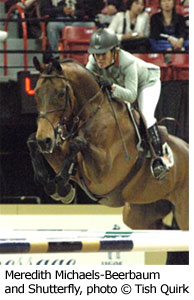 With only six riders remaining, it was not until Meredith Michaels-Beerbaum, the number one rider in the world and a two-time World Cup Champion, trotted into the arena on Shutterfly (Octavia Farms LLC, Meredith Michaels-Beerbaum, owners) that Liebherr’s reign ended. Michaels-Beerbaum, a former Californian who is now a German citizen, jumped a fantastic round, taking many of the inside tracks with seeming ease and leaving the rails untouched to end with a time of 56.48 and first place. She proved untouchable.
With only six riders remaining, it was not until Meredith Michaels-Beerbaum, the number one rider in the world and a two-time World Cup Champion, trotted into the arena on Shutterfly (Octavia Farms LLC, Meredith Michaels-Beerbaum, owners) that Liebherr’s reign ended. Michaels-Beerbaum, a former Californian who is now a German citizen, jumped a fantastic round, taking many of the inside tracks with seeming ease and leaving the rails untouched to end with a time of 56.48 and first place. She proved untouchable.
Both Ward and Fellers are easily in striking distance of the lead as they sit third and fourth, and this is a long competition. Friday night they face a challenging test. American riders showed their depth with very strong performances by up and coming stars Hillary Dobbs, Ashlee Bond, and Michelle Spadone. Richard Spooner was on a winning pace with Ace, but a rail in the triple and another after a very tight roll back to fence 11 dropped the pair down in the standings. However, clear rounds count and Spooner is more than capable.
THURSDAY: DRESSAGE
Competition kicked into high gear today, with the opening ceremonies and Grand Prix Dressage competition. Fourteen horses entered the court to vie for their share of $100,000 in prize money.
Once the show got under way, it had a shaky beginning, especially for the Americans. First Jan Eberling had a rocky ride on Rafalca, who seemed concerned about something in the corner between C and H. Eberling persevered and finished the ride, earning a 53.995 despite the foibles. However, he did not qualify to participate in the Freestyle on Saturday.
Next, Leslie Morse and Kingston began their test, but something was obviously wrong when their extended trot was severely lacking. The judge at C rang the bell when Morse reached H and excused her from the arena. Morse dismounted and led Kingston out of the arena to tumultuous applause. “I could tell in the first corner, he felt unbalanced and I knew he wasn’t right,” Morse was reported to say in a press release from the event. “We respect the Ground Jury’s decision to ring the bell and we all agreed it was absolutely in the best interest of the horse, which is always the most important consideration.”
Isabell Werth, who was the winner here two years ago, put in a beautiful ride for third place and with Satchmo, earning several 9s through the test and a 10 on the half pass, with a final score of 73.745. Nine-time World Cup Champion Anky Van Grunsven and IPS Painted Black followed Werth, putting on a strong performance with several 9s throughout and a 10 on the extended trot. She ended with a respectable 74.170. This was IPS Painted Black’s first World Cup. “I’m really happy,” she said. “It was his best Grand Prix of the season.”
Werth and Van Grunsven are tough acts to follow, but when Steffen Peters and Ravel entered the arena, it was clear they were ready. After numerous 8s and 9s, including the piaffe, Peters’ score continued to rise. During his last piaffe, the crowd began to murmur, and the excitement in the air was palpable. The audience was on the edge of their seats, watching as the collective scores flashed up on the screen. Peters’ score of 77.915, unanimous first with all judges, made him the clear winner. Everyone in the crowd was on their feet as Peters waved to them, grinning from ear to ear.
At the press conference after the awards presentation Peters’ emotion was obvious. “I was beside myself. I couldn’t believe it. I had to keep looking at the score to make sure.” Peters said he would follow the advice Van Grunsven gave him in Florida, which is to keep the same routine when preparing for the Freestyle and not to change anything even though he is in the lead.
The last time the FEI World Cup Dressage was won by a rider from the USA was in 2003, when Debbie McDonald took it with Brentina.
FRIDAY: SHOW JUMPING
This class was run in a traditional jump-off format, and course designer Anthony D’Ambrosio posed some challenges for the riders. The jumps were bigger and required even more scope than the speed round. The time allowed was not a significant factor, but in the small arena there isn’t much option for veering off the track and slowing down too much. Of the 42 starters, 13 negotiated clear rounds.
It was not until the 11th ride, Keean White of Canada with Celena Z, that we saw the first clear round, followed immediately by another one from Helena Lundback of Sweden on Madick. Of the 13 riders who went clear and moved on to the jump-off, five were from the US: Richard Spooner on Cristallo, Beezie Madden on Danny Boy, Hillary Dobbs on Quincy B, Rich Fellers on Flexible, and McLain Ward on Sapphire. Meredith Michaels-Beerbaum on Shutterfly, last night’s winner, was last to go and also went clear, as did Christina Liebherr, who was second last night.
After the final ride in the first round, the ring crew quickly prepared for what was bound to be an exciting jump-off. There were ample opportunities to cut corners and make up time, which some of them put to full advantage.
First up in the jump-off was White, who dropped a rail on the second jump and finished in 40.83. He was followed by Lundback, who jumped a clear round in 37.20. She was only at the top of the leader board for a moment before being knocked down first by Spooner with 34.87, then Madden with 34.83. Dobbs, Forsten, and Pessoa all dropped a rail apiece, so Madden was still leading until Albert Zoer of Netherlands, who was sixth last night, jumped a clear round in 34.72.
Excitement was high when last night’s fifth place finisher, Thomas Velin, entered the arena on Grim St. Clair, but he knocked down nearly the whole fence at five and put himself out of the running. The crowd went wild when favorite Fellers, last year’s second place finisher and fourth last night, entered the arena. He took the course at a breakneck pace, but he had a rail at fence three and this, combined with his fast time of 34.42, put him in eighth place.
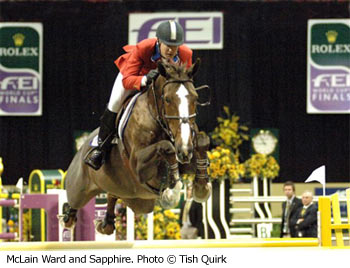 Ward was next up, and the stadium filled with applause once again. He and Sapphire put on a brilliant performance, taking some very tight turns to save valuable time, and finished in a seemingly impossible 33.77 with no faults, sending himself to the top of the leader board and leaving Zoer in second and Madden in third. They stayed there when Liebherr had a refusal at jump two, dropped a rail at six and had two time faults, leaving her with a disappointing 13th place finish.
Ward was next up, and the stadium filled with applause once again. He and Sapphire put on a brilliant performance, taking some very tight turns to save valuable time, and finished in a seemingly impossible 33.77 with no faults, sending himself to the top of the leader board and leaving Zoer in second and Madden in third. They stayed there when Liebherr had a refusal at jump two, dropped a rail at six and had two time faults, leaving her with a disappointing 13th place finish.
Finally, Michaels-Beerbaum nearly brought down the house when she rode in on Shutterfly, and the crowed eagerly waited to see if she would repeat last night’s performance and take home yet another Rolex watch. She delivered, neatly taking the tightest possible turns and finishing a full second ahead of Ward and claiming the leader’s spot.
The other two West Coast riders, Mandy Porter (San Diego) and Ashlee Bond (Cadett 7) each caught a single rail in the first round. Although they are not in contention for a top prize, they both qualified for Sunday’s final competition. There is no doubt that Ward is nipping at Michaels-Beerbaum’s heels, but Michaels-Beerbaum is an experienced international competitor having made her mark in Germany, the bastion of show jumping. Ranked first in the world, this California born and now German resident will cooly work to defend her title. Both Ward and Fellers are within grasp of the title and they will keep the pressure on. Stay tuned because in show jumping anything can happen!
FRIDAY: DRESSAGE
The second day of dressage competition at the FEI World Cup Finals was a bit more relaxed than the previous day, with only exhibition competitions and one very special presentation on the schedule. There was a whole lot of fun, a few tears, and a great day of dressage for all. You didn’t have to be an aficionado to enjoy today’s showcase.
The Hermes and Der Dau Pas de Deux Challenge included three Olympic riders teamed up with their students or peers for three fun and exciting routines. Eschewing the traditional black-and-whites for coordinating costumes complete with bling, each pair of riders performed a Grand Prix Musical Freestyle that added the challenge of staying in sync with each other to the already difficult movements. The exhibition was run like “Dancing with the Stars,” with scores from judges Wojtek Markowski (the show’s Foreign Technical Deligate) and Linda Zang, and audience participation combined to determine the winners.
Last to enter the arena for the Pas de Deaux exhibition was Guenter Seidel on Fandango and Elizabeth Ball on Orion. Dressed as The Phantom of the Opera and Christine Daaé, they were already a cut above the other teams before they even started their performance. However, they soon proved they were not all clothes and no substance, because every movement was not only beautifully ridden, but about as perfectly in sync as you can expect two horses to be.
“Your spirit and my voice…in one, combined,” lyrics from one of the Phantom songs used in their routine is the perfect description of a dressage horse and rider, and this pair in particular. The routine culminated in the two riders side by side in a passage up centerline, holding hands with a rose between them. The crowd was on their feet at the final bow, and it was clear who the winner would be. The judges were equally impressed, awarding an 11 (out of 10) from Markowski and a 10 from Zang.
Next on the agenda was the International Superstar Young Horse Exhibition, during which judge Zang explained the Young Horse program. Four Young horses were brought into the arena: Zidane with yesterday’s champion Steffen Peters, Wynton with Edward Gal, Valeska DG with Willy Arts and Big Tyme with Marisa Festerling.
Finally, it was time for Brentina’s retirement ceremony. Her owners, Parry and Peggy Thomas, were brought into the darkened arena under a spotlight and presented with roses and a plaque thanking them for their contributions to the sport. Emotions were high as a retrospective of Brentina’s career played on the JumboTron, and then the crowd rose to their feet as the mare of the hour entered the arena with Debbie MacDonald astride.
MacDonald covered her face several times, clearly unable to contain her emotions as she and Brentina walked around the arena while the announcer read the words she wrote, words written in Brentina’s voice, saying good-bye and thank you to all of her fans. MacDonald rode into the center and dismounted, and tears flowed freely in all corners when the saddle was removed from Brentina’s back. Several presentations were made, including a sash, roses and a cooler, then MacDonald led her faithful partner out of the arena to tumultuous applause accompanied by Aretha Franklin’s RESPECT. It was a fitting end to the career of this most celebrated of horses, one that will not be forgotten…and nor will she.
SATURDAY: SHOW JUMPING
Over 7,000 spectators were in attendance to watch the show, beginning with the Las Vegas Grand Prix, a separate competition on the off day for the horses and riders competing in the World Cup Final. Twenty-one riders faced the course, including several World Cup riders who rode a second horse or decided to opt out of tomorrow’s leg of the Final.
It wasn’t until the seventh ride, USA’s Michelle Spadone and Melisimo, that we saw the fences stay intact—but her time of 85.08 gave her a time fault and left her out of the jump-off. Two rides later, the youngest rider in the competition was the first to enter the jump-off. Nineteen-year-old Laura Teodori of Scottsdale piloted Kasoar D’Uxelles around the course clean and within time. Sacramento, California resident Jill Humphrey nearly joined her with Kaskaya, but finishing in 85.28—she joined Spadone with just a single time fault.
Four more riders managed to jump around fault-free within the time allowed: HRH Prince Abdullah Al-Saud of the Kingdom of Saudi Arabia aboard Mobily Ashkur Allah Obelix (36th last night), Geir Gulliksen of Norway on Sundal Colliers Cattani (30th last night), USA’s Rich Fellers with his second horse, Kilkenny Rindo, and Gerco Schroder of Netherlands on Eurocommerce Seattle.
Teodori was first to make a jump-off attempt, but dropping two rails left room for others to go clean. Prince Abdullah Al-Saud was next, putting in a clear round at 38.61. Gulliksen had trouble in the same exact spots as Teodori, knocking down nearly the whole fence at three.
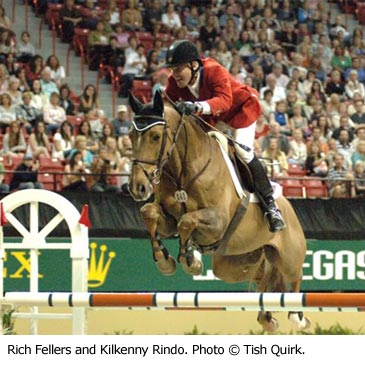 Fellers entered the arena to a roar of applause and cheers, ready to challenge Prince Abdullah Al-Saud. He rode a breathtaking round, cutting corners and taking the fences at daring angles. The energy from the audience increased with each effort. Every rail was in place when he crossed the timers in 36.83, an impressive 1.78 seconds ahead of the previous leader.
Fellers entered the arena to a roar of applause and cheers, ready to challenge Prince Abdullah Al-Saud. He rode a breathtaking round, cutting corners and taking the fences at daring angles. The energy from the audience increased with each effort. Every rail was in place when he crossed the timers in 36.83, an impressive 1.78 seconds ahead of the previous leader.
Schroder made a valiant effort to catch up. His fate was sealed, however, when he dropped a rail at the second fence, and his best shot was to go for third place. He managed it, ending in 37.53.
In a press conference following the events, Las Vegas Grand Prix winner Fellers commented that Kilkenny Rindo just started jumping at this level in November of 2008. A solid win for owners Sheryl and Doug Boyd, the Kilkenny Crest show horses, of which there are many, are in good hands with Fellers. And Kilkenny Rindo is on his way to an excellent Grand Prix career.
SATURDAY: REINING
After the awards were presented to the jumpers, the arena was cleared for the International Reining Celebrity Challenge, which allowed some riders to ditch their breeches and helmets for jeans and cowboy hats, and to show that a good horseman is a good horseman. Two teams were assembled: Rodrigo Pessoa, Anky Van Grunsvan, and NRHA World Champion Ann Fonck for the International team, and Will Simpson, Charlotte Bredahl-Baker and NRHA World Champion Rick Weaver for the USA team. AQHA was present to oversee the event.
Pessoa started the competition with a respectable but careful ride, scoring 118.5 from the judges. Simpson came next, delighting the audience with some good spins, transitions from the gallop to the slow circle, and then the hallmark of the reining horse, the run to sliding stop. He earned an impressive 144.5 for his effort.
Van Grunsven was next. She put on a good show, the crowd loved it, and received a score of 141.5. Bredahl-Baker’s horse got a little jittery and only earned 125—good enough to keep the US team in the lead.
When it was Fonck’s turn, she took all the riders to school. The audience was treated to some fantastic, world-class reining during her run and got a good laugh when she stopped one of her spins facing the wrong direction. It did not affect her score too much, she was given a 147, bringing the International team’s total to 407.
Weaver was the last to enter the pen, egging the audience on all the way through a stellar performance. Although his score fell just below Fonck’s—and Simpson’s—at 144, it was enough to seal the victory for the US Team.
At the press conference later in the afternoon, both Bredahl-Baker and Simpson said they enjoyed the change in costume and had a great time.
“The response these reining horses have is incredible,” said Simpson.
Bredahl-Baker added, “This was the most fun I’ve had in a long time. I’m a little bit hooked.”
Weaver and Fonck both seemed to enjoy the experience as well. “The quality of horse and horsemen here is something I’ll take away. They did an outstanding job.”
SATURDAY: DRESSAGE FINAL DAY
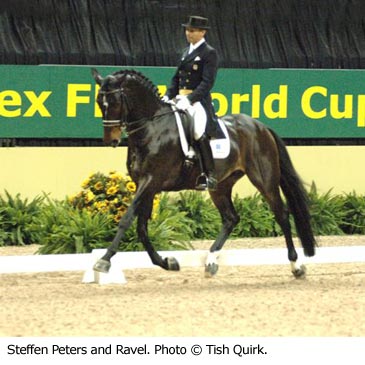
Excitement was high tonight for the Musical Freestyle leg of the FEI World Cup Dressage competition. The World Cup title was on the line, and it was
a close race between the 2007 winner Isabell Werth of Germany, last year’s winner and nine-time champion Anky van Grunsven of Netherlands, and Thursday’s winner Steffen Peters of the United States. As the scores rolled in it became clear that for the first time in 23 years, an American won the World Cup on American soil.
The competition began to really heat up after the break, when first Monica Theodorescu of Germany and Whisper took the lead with 76.85, then Hans Peter Minderhoud of Netherlands and Exquis Nadine with a score of 81.05. Minderhoud was immediately bumped from the lead position by Werth and Satchmo (third place on Thursday), who scored 84.5 for her beautifully choreographed and ridden freestyle—including an artistic score of 92.
When the moment came for Peters and Ravel to perform, the air in the arena was electric. From the moment they trotted into the arena, it was clear he was there to win. His extensions were beautiful, his half passes were elastic, and his piaffe and passage were strong, as well as throughout these movements, the horse truly danced to the music. The audience loved every second of his performance.
The crowd was on their feet at the final halt, rising again and again every time he passed as he walked around the ring, waiting for his scores. His overall score of 84.950 shot him to the top of the leader board. His artistic score of 93 showed that this was exactly how a musical freestyle should be ridden.
There was great tension in the room when “The Queen of the Kur” van Grunsven rode in on IPS Painted Black. Nearly every beat of the music was perfectly timed to the stallion’s footfalls. However, they made a mistake in the two-tempis and their overall level of difficulty and execution did not meet the standard that had been set by the two previous riders. Her score of 82.25 was only good enough for third place.
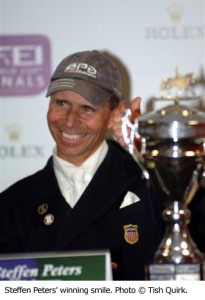 Peters’ accomplishment is particularly impressive given that he has only been riding Ravel for 14 months. “He has a great mind,” Peters said at a press conference after the award ceremony. “I’m one of the really lucky guys in the world who gets to ride a horse like that.”
Peters’ accomplishment is particularly impressive given that he has only been riding Ravel for 14 months. “He has a great mind,” Peters said at a press conference after the award ceremony. “I’m one of the really lucky guys in the world who gets to ride a horse like that.”
Of the win, Peters said, “It’s just an incredible feeling.” Showing off his second Rolex watch of the week, he said, “This is incredible support from the sponsors, Rolex. We really appreciate it.”
Van Grunsven appeared genuinely happy for Peters and with her performance on IPS Painted Black. “I was really happy. It was his first big competition like this. He did well.”
After the freestyle performances were over, Jan Brink and Bjorsells Briar were invited back into the arena to say their final good-bye to International competition, as Briar is retiring at the age of 18. And thus ended another year of fantastic FEI World Cup Dressage, with many fond memories for dressage fans to take home.
SUNDAY: SHOW JUMPING FINAL DAY
The 2009 Rolex FEI World Cup Finals concluded with two thrilling rounds of jumping competition. Twenty-nine horses entered this third leg of the Final, which started on Thursday. Meredith Michaels-Beerbaum remained at the top of the leader board after her victories on Thursday and Friday, but McLain Ward was hot on her heels.
This round of the competition is run in a format unique to the World Cup. The placings from the first two rounds were converted into World Cup penalty points to determine the overall ranking. Then, the riders rode the first round of the day, in which their faults were added to their World Cup points. The 22 riders with the lowest score, along with any with clean rounds who chose to ride again, moved on to the next round—which was scored the same way.
Course Designer Anthony D’Ambrosio continued to increase the difficulty each round. Both legs of Sunday’s competition had 12 efforts, as high as 1.62m (5’3”) and as wide as 1.85m (6’).
 Despite the questions asked on course, however, there were 11 clear rounds, including three riders from the United States: Todd Minikus with Pavarotti, Beezie Madden with Danny Boy, and McLain Ward with Sapphire. Twenty-three riders moved on to the second round, led by Michaels-Beerbaum with zero points, Ward with two, and Albert Zoer close behind with four. With the top three so close together, just one time fault or rail dropped could significantly change the standings.
Despite the questions asked on course, however, there were 11 clear rounds, including three riders from the United States: Todd Minikus with Pavarotti, Beezie Madden with Danny Boy, and McLain Ward with Sapphire. Twenty-three riders moved on to the second round, led by Michaels-Beerbaum with zero points, Ward with two, and Albert Zoer close behind with four. With the top three so close together, just one time fault or rail dropped could significantly change the standings.
For the second round, D’Ambrosio increased the technical and physical aspects up a notch, including several tests of scope for these horses and riders—who had already jumped a challenging course just a short time before. The biggest problem spot was the final oxer. At 1.85m wide, nine of the twenty-three riders did not get quite high enough to clear the width.
The first to go clean was Steve Guerdat of Switzerland with Tresor. He finished with 19 World Cup points for the 2009 competition, which put him in eighth place. Last year’s second place winner and crowd favorite Rich Fellers had a difficult day with enough faults to drop him in the rankings and out of contention for the title.
The cheers were loud for Rodrigo Pessoa, who having jumped clear in the first round today improved his ranking from seventh to fifth place going into the second round. Almost clean, he had a rail on the last jump and finished fifth overall.
Christina Liebherr and L.B. No Mercy, fabulous and second on Thursday but encountering some problems on Friday and placing 13th, was in fifth place overall going into the first round today. Illustrating that her Friday performance was not to be repeated, the pair jumped two clear rounds, moving up to fourth place.
Albert Zoer and Oki Doki put in yet another clear round and stayed in third. With only four penalty points, he was still in reach of the title if Ward and Michaels-Beerbaum riding after him had any faults.
The arena filled with thunderous applause for Ward, who with only two penalty points had a chance to take the title away from Michaels-Beerbaum. To the crowd’s delight, Ward and Sapphire had a flawless round, maintaining his second place rank and continuing to nip at Meredith’s heels.
All that was left was to see was if Michaels-Beerbaum would continue her streak of clear rounds. Just one rail would push her down to a tie with Zoer, but the pressure did not seem to affect her. She rode yet another cool and perfect round, leaving every rail in place and clinching the title for herself and Shutterfly. This win makes for the third World Cup title for this dynamic duo.
 “I think this was absolutely a great event,” said Michaels-Beerbaum at a press conference after the awards ceremony. “The best horses and riders were here.” She also said, “I think this was my most perfect win, winning all three rounds, but it was also the hardest win ever. McLain made it difficult for me, there was no room for error.” She added that it was a good come-back after her just missed bronze medal experience in Hong Kong.
“I think this was absolutely a great event,” said Michaels-Beerbaum at a press conference after the awards ceremony. “The best horses and riders were here.” She also said, “I think this was my most perfect win, winning all three rounds, but it was also the hardest win ever. McLain made it difficult for me, there was no room for error.” She added that it was a good come-back after her just missed bronze medal experience in Hong Kong.
As for Ward, he said, “We came up two seconds short. It’s a fine line in sports but that’s what it is all about. I’m very proud of what my horse did this week. I’m proud of my team.”
Michaels-Beerbaum took home a grand total for the week of over $230,000 and three Rolex watches. For second place, Ward earned a grand total of over $158,000, and Zoer a grand total of over $98,000.
In 2010, the show jumping event will be held in Geneva, Switzerland, the home of Rolex, and in ‘S Hertogenbosch, Netherlands, for dressage.
 Congratulations to the USEF Talent Search Final Four
Congratulations to the USEF Talent Search Final Four

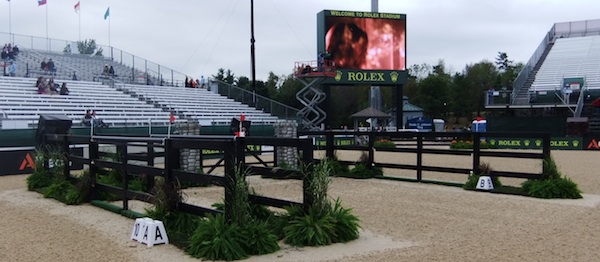



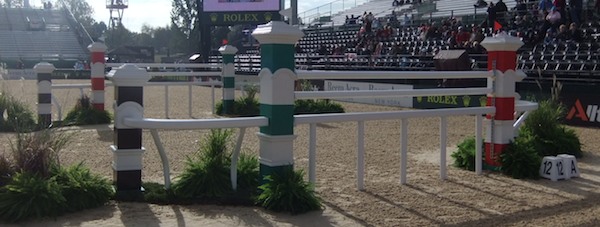


 Representing the West Coast, Duncan McFarlane piloted the eight-year-old Mr. Whoopy to an impressive eighth place finish, dropping just one rail on course, and Helen McNaught rode Caballo to the thirteenth position with an eight fault score.
Representing the West Coast, Duncan McFarlane piloted the eight-year-old Mr. Whoopy to an impressive eighth place finish, dropping just one rail on course, and Helen McNaught rode Caballo to the thirteenth position with an eight fault score. The WEG is here!
The WEG is here!
 We Bring You La Baule
We Bring You La Baule


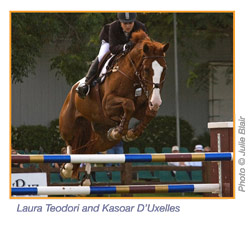
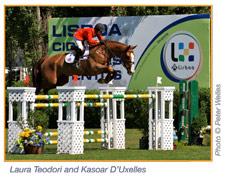 EqSol: Almost directly after Vegas in April was Europe in May. How did that come about?
EqSol: Almost directly after Vegas in April was Europe in May. How did that come about? While we make our way through one of the most challenging economic times we’ve had as a nation, if not the world, there are shining stars and glimmers of light at the end of the tunnel. Whether the economy is up or down, our own niche of sport horses never ceases to please and amaze us. Take a close look at this week’s stories from Carleton to Compton to World Cup.
While we make our way through one of the most challenging economic times we’ve had as a nation, if not the world, there are shining stars and glimmers of light at the end of the tunnel. Whether the economy is up or down, our own niche of sport horses never ceases to please and amaze us. Take a close look at this week’s stories from Carleton to Compton to World Cup.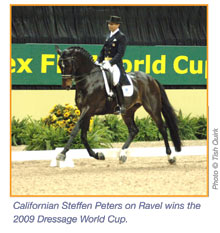 Next, our American top hats are off to Steffen Peters who dressaged his way to a World Cup win over some of the world’s best riders. His high scores included a 93 in the artistic category on the final night, as his horse Ravel danced to the music of his freestyle ride. Notable that Meredith was American-born, but is now a German citizen whereas Steffen was German-born and now lives and trains in nearby Escondido, CA.
Next, our American top hats are off to Steffen Peters who dressaged his way to a World Cup win over some of the world’s best riders. His high scores included a 93 in the artistic category on the final night, as his horse Ravel danced to the music of his freestyle ride. Notable that Meredith was American-born, but is now a German citizen whereas Steffen was German-born and now lives and trains in nearby Escondido, CA.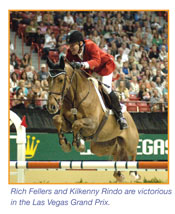 The room was buzzing at the final press conference on Sunday, not only with the excitement of the fabulous sport all had witnessed, but at the conclusion Robert Ridland made an announcement that put the icing on the Las Vegas FEI World Cup cake. After ten years of participation, Ridland took the time to honor some of the many names that made this phenomenal event possible year after year, including John Quirk, Bob Maxey, Shawn Davis, Tim Keener and Pat Christensen, among others. He then stated that Blenheim EquiSports, with the full support of Las Vegas Events, would be making a bid to bring the FEI World Cup Finals back to Las Vegas in 2014. “This team, this event is too good to give up,” he said. In response to this announcement Sven Holmberg, FEI Vice President, replied with a smile that the 2014 bid would be “very well received.”
The room was buzzing at the final press conference on Sunday, not only with the excitement of the fabulous sport all had witnessed, but at the conclusion Robert Ridland made an announcement that put the icing on the Las Vegas FEI World Cup cake. After ten years of participation, Ridland took the time to honor some of the many names that made this phenomenal event possible year after year, including John Quirk, Bob Maxey, Shawn Davis, Tim Keener and Pat Christensen, among others. He then stated that Blenheim EquiSports, with the full support of Las Vegas Events, would be making a bid to bring the FEI World Cup Finals back to Las Vegas in 2014. “This team, this event is too good to give up,” he said. In response to this announcement Sven Holmberg, FEI Vice President, replied with a smile that the 2014 bid would be “very well received.” With only six riders remaining, it was not until Meredith Michaels-Beerbaum, the number one rider in the world and a two-time World Cup Champion, trotted into the arena on Shutterfly (Octavia Farms LLC, Meredith Michaels-Beerbaum, owners) that Liebherr’s reign ended. Michaels-Beerbaum, a former Californian who is now a German citizen, jumped a fantastic round, taking many of the inside tracks with seeming ease and leaving the rails untouched to end with a time of 56.48 and first place. She proved untouchable.
With only six riders remaining, it was not until Meredith Michaels-Beerbaum, the number one rider in the world and a two-time World Cup Champion, trotted into the arena on Shutterfly (Octavia Farms LLC, Meredith Michaels-Beerbaum, owners) that Liebherr’s reign ended. Michaels-Beerbaum, a former Californian who is now a German citizen, jumped a fantastic round, taking many of the inside tracks with seeming ease and leaving the rails untouched to end with a time of 56.48 and first place. She proved untouchable. Ward was next up, and the stadium filled with applause once again. He and Sapphire put on a brilliant performance, taking some very tight turns to save valuable time, and finished in a seemingly impossible 33.77 with no faults, sending himself to the top of the leader board and leaving Zoer in second and Madden in third. They stayed there when Liebherr had a refusal at jump two, dropped a rail at six and had two time faults, leaving her with a disappointing 13th place finish.
Ward was next up, and the stadium filled with applause once again. He and Sapphire put on a brilliant performance, taking some very tight turns to save valuable time, and finished in a seemingly impossible 33.77 with no faults, sending himself to the top of the leader board and leaving Zoer in second and Madden in third. They stayed there when Liebherr had a refusal at jump two, dropped a rail at six and had two time faults, leaving her with a disappointing 13th place finish. Fellers entered the arena to a roar of applause and cheers, ready to challenge Prince Abdullah Al-Saud. He rode a breathtaking round, cutting corners and taking the fences at daring angles. The energy from the audience increased with each effort. Every rail was in place when he crossed the timers in 36.83, an impressive 1.78 seconds ahead of the previous leader.
Fellers entered the arena to a roar of applause and cheers, ready to challenge Prince Abdullah Al-Saud. He rode a breathtaking round, cutting corners and taking the fences at daring angles. The energy from the audience increased with each effort. Every rail was in place when he crossed the timers in 36.83, an impressive 1.78 seconds ahead of the previous leader.
 Peters’ accomplishment is particularly impressive given that he has only been riding Ravel for 14 months. “He has a great mind,” Peters said at a press conference after the award ceremony. “I’m one of the really lucky guys in the world who gets to ride a horse like that.”
Peters’ accomplishment is particularly impressive given that he has only been riding Ravel for 14 months. “He has a great mind,” Peters said at a press conference after the award ceremony. “I’m one of the really lucky guys in the world who gets to ride a horse like that.” Despite the questions asked on course, however, there were 11 clear rounds, including three riders from the United States: Todd Minikus with Pavarotti, Beezie Madden with Danny Boy, and McLain Ward with Sapphire. Twenty-three riders moved on to the second round, led by Michaels-Beerbaum with zero points, Ward with two, and Albert Zoer close behind with four. With the top three so close together, just one time fault or rail dropped could significantly change the standings.
Despite the questions asked on course, however, there were 11 clear rounds, including three riders from the United States: Todd Minikus with Pavarotti, Beezie Madden with Danny Boy, and McLain Ward with Sapphire. Twenty-three riders moved on to the second round, led by Michaels-Beerbaum with zero points, Ward with two, and Albert Zoer close behind with four. With the top three so close together, just one time fault or rail dropped could significantly change the standings. “I think this was absolutely a great event,” said Michaels-Beerbaum at a press conference after the awards ceremony. “The best horses and riders were here.” She also said, “I think this was my most perfect win, winning all three rounds, but it was also the hardest win ever. McLain made it difficult for me, there was no room for error.” She added that it was a good come-back after her just missed bronze medal experience in Hong Kong.
“I think this was absolutely a great event,” said Michaels-Beerbaum at a press conference after the awards ceremony. “The best horses and riders were here.” She also said, “I think this was my most perfect win, winning all three rounds, but it was also the hardest win ever. McLain made it difficult for me, there was no room for error.” She added that it was a good come-back after her just missed bronze medal experience in Hong Kong.